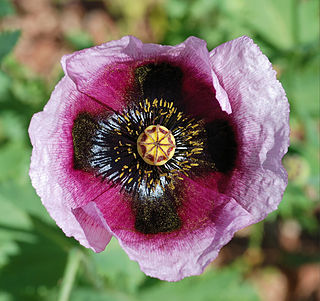
Papaver is a genus of 70–100 species of frost-tolerant annuals, biennials, and perennials native to temperate and cold regions of Eurasia, Africa and North America. It is the type genus of the poppy family, Papaveraceae.

The Papaveraceae are an economically important family of about 42 genera and approximately 775 known species of flowering plants in the order Ranunculales, informally known as the poppy family. The family is cosmopolitan, occurring in temperate and subtropical climates, but almost unknown in the tropics. Most are herbaceous plants, but a few are shrubs and small trees. The family currently includes two groups that have been considered to be separate families: Fumariaceae and Pteridophyllaceae.
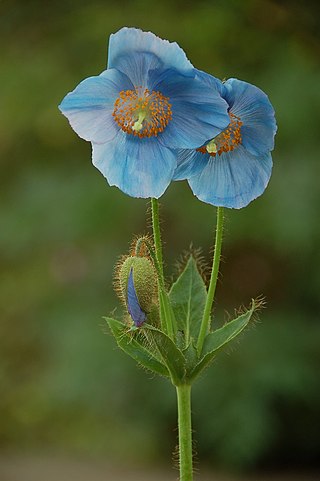
Meconopsis is a genus of flowering plants in the poppy family Papaveraceae. It was created by French botanist Viguier in 1814 for the species known by the common name Welsh poppy, which Carl Linnaeus had described as Papaver cambricum. The genus name means "poppy-like". Himalayan species discovered later were also placed in Meconopsis. In the 21st century, it was discovered that the Himalayan species were less closely related to the Welsh poppy, which has been restored to Papaver. All species now placed in Meconopsis are native to the Himalayas and surrounding regions. They have attractive, usually blue flowers.

Papaver cambricum, synonym Meconopsis cambrica, the Welsh poppy, is a perennial flowering plant in the poppy family Papaveraceae. It has yellow to orange flowers and is widely grown as a garden plant. It is a native of damp, rocky sites in upland areas of Western Europe from the British Isles to the Iberian Peninsula. It has been used since 2006 as the basis for the logo of the political party Plaid Cymru.

Meconopsis betonicifolia, the Himalayan blue poppy, is a species of flowering plant in the family Papaveraceae. It was first formally named for western science in 1912 by the British officer Lt. Col. Frederick Marshman Bailey.
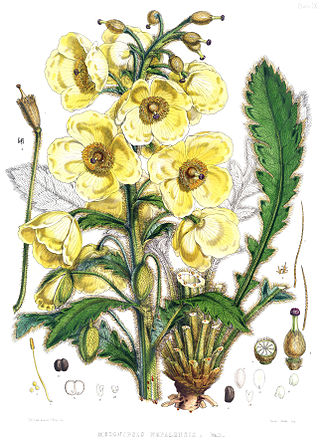
Meconopsis napaulensis, the Nepal poppy or satin poppy, is a plant of the family Papaveraceae. The plant contains beta-carbolines, which act as a psychedelic drug. However, its phytochemistry remains predominantly unstudied.
Meconopsis villosa, the Himalayan woodland-poppy, is an ornamental poppy, which is native of Nepal. The species was placed in the genus Cathcartia erected by J.D. Hooker to honour J.F. Cathcart, an Indian civil servant and amateur botanist who collected and hired native artists to illustrate the flowers of the Himalayas. It was transferred to Meconopsis by George Taylor in 1934. In 2017, it was suggested that the genus Cathcartia should be revived, and this species again treated as Cathcartia villosa.

Arctomecon is a genus of the poppy family Papaveraceae commonly called the bear poppies or bear-paw poppies, after the distinctive appearance of the leaves. The three species occur only in the northeastern part of the Mojave Desert of North America, and are all uncommon.

Roemeria argemone is a species of flowering plant in the poppy family Papaveraceae. Its common names include long pricklyhead poppy, prickly poppy and pale poppy. Its native range includes parts of Eurasia and North Africa, but it can be found growing wild in parts of North America, where it is an introduced species. It is cultivated as an ornamental plant.

Meconopsis grandis, the Himalayan blue poppy, is a species of flowering plant in the poppy family Papaveraceae, native to China (Yunnan), Bhutan, North East India and Nepal.
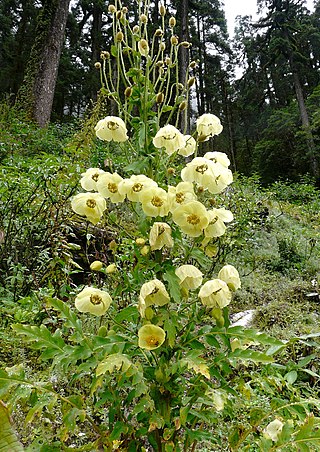
Meconopsis autumnalis, the Nepalese autumn poppy, is a yellow-flowered Himalayan poppy belonging to series Robustae, and is endemic to the Ganesh Himal range of central Nepal, where it was discovered in 2008 on a research expedition from the University of Aberdeen. In addition to several morphological features, the species is characterised by its late flowering period, which has more than likely resulted in a barrier to gene flow and subsequent evolutionary divergence from the closely related and sympatric species Meconopsis paniculata.

Meconopsis manasluensis is a red-flowered Himalayan poppy belonging to Meconopsis subg. Discogyne, which forms a natural grouping of 6 or 7 species within the genus all characterised by a stylar disc surmounting the ovary. As reflected by the species etymology, M. manasluensis is endemic to the vicinity of the Manaslu Himal of Gorkha district, central Nepal, where it grows at high elevation and so far remains known only from its type collection locality.
Meconopsis bella is commonly known as the pretty blue poppy. M. bella is a species of the genus Meconopsis which is found from central Nepal to southeastern Tibet. It is a herbaceous flowering plant and is a part of the poppy family Papaveraceae. This plant is also referred to as Meconopsis bella prain, since it was aptly names by the botanist Prain.

Meconopsis horridula, the prickly blue poppy, is a flowering plant from the family Papaveraceae. It is an endangered species that grows in high altitudes. The height of the plant varies from 20 cm to 1m. It is a monocarpic, dicot plant.

Papaveroideae is a subfamily of the family Papaveraceae.
Meconopsis lancifolia is a plant species in the genus Meconopsis, in the family Papaveraceae. M. lancifolia is monocarpic, meaning that it flowers only once before dying.
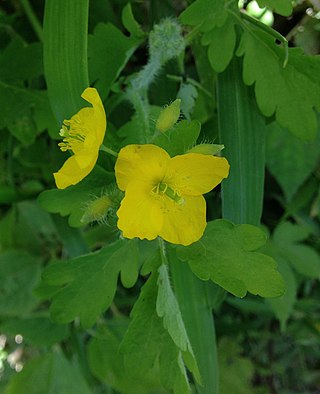
Chelidonium, commonly known as celandines, is a small genus of flowering plants in the poppy family, This genus is native to northern Africa and Eurasia, where they are widespread, ranging from western Europe to east Asia.
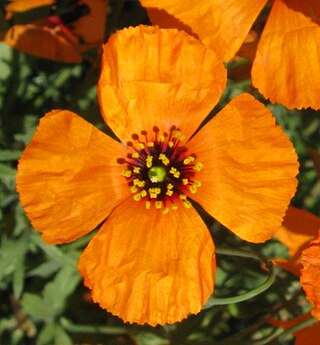
Papaver heterophyllum, previously known as Stylomecon heterophylla, and better known as the wind poppy, is a winter annual herbaceous plant. It is endemic to the western California Floristic Province and known to grow in the area starting from the San Francisco Bay Area of Central Western California southwards to northwestern Baja California, Mexico. Its main habitat is often described as mesic and shady, with loamy soils such as soft sandy loam, clay loam, and leaf mold loam.
Papaver quintuplinervium, the harebell poppy, is a species of flowering plant in the family Papaveraceae, native to China. As its synonym Meconopsis quintuplinervia it has gained the Royal Horticultural Society's Award of Garden Merit.

Oreomecon is a genus in the poppy family Papaveraceae. It was established in 2022 for what was previously treated as Papaver sect. Meconella in order to ensure that the genus Papaver was monophyletic. As of June 2023, names in the genus Oreomecon had only been published for better known and phylogenetically understood species present in Europe, either as natives or aliens.














